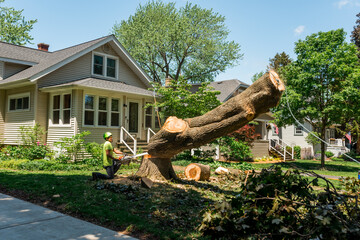Trees add shade, beauty, and value to properties, but there are times when tree removal becomes necessary. Whether due to safety hazards, disease, or landscaping plans, removing a tree requires careful planning and professional techniques. Understanding when and why tree removal is needed can help homeowners and property managers maintain safe, functional, and attractive outdoor spaces.

The Importance of Tree Removal
While trees are an important part of the environment, not every tree is safe to keep standing. Trees that are dead, diseased, or damaged can pose significant risks. Weak or unstable branches may fall during storms, while rotting trunks can collapse unexpectedly. Removing hazardous trees protects people, homes, vehicles, and nearby structures from potential accidents.
Tree removal is also important for maintaining healthy landscapes. Diseased trees can spread infections to surrounding vegetation, while overcrowded areas may prevent other plants from thriving. By removing unsafe or unhealthy trees, you create space for healthier growth and safer surroundings.
Common Reasons for Tree Removal
There are several situations in which tree removal becomes necessary. The most common include:
- Disease or Pest Infestation – Trees affected by fungi, insects, or rot often need to be removed to prevent further damage.
- Storm Damage – Severe weather can weaken tree structures, making them unstable and unsafe.
- Dead or Dying Trees – A tree that no longer produces leaves or shows signs of decay can become a serious hazard.
- Root Damage – Roots growing too close to foundations, driveways, or underground pipes can cause costly damage.
- Overcrowding – Too many trees in one space can restrict growth, sunlight, and airflow.
- Landscaping or Construction Plans – Sometimes trees are removed to make way for new designs, buildings, or outdoor features.
Identifying these issues early helps property owners take action before problems worsen.
The Tree Removal Process
Tree removal is not as simple as cutting down a trunk. It requires careful planning and execution to ensure safety and efficiency. The process often involves:
- Assessment – The tree’s condition, size, and location are evaluated to determine the safest approach.
- Preparation – Surrounding areas are cleared to prevent damage to nearby structures, plants, or property.
- Cutting – Branches are removed first to reduce weight and control the fall. Then the trunk is carefully cut down into sections.
- Stump Removal or Grinding – After the tree is cut down, the stump may be removed completely or ground down to prevent regrowth.
- Cleanup – Debris, branches, and wood are cleared, leaving the area safe and ready for future use.
Because of the risks involved, tree removal is often best left to trained professionals with the right equipment and expertise.
Safety Considerations in Tree Removal
Safety is the most important factor in any tree removal project. Cutting down a tree involves potential hazards such as falling branches, heavy equipment, and unstable trunks. Proper protective gear, ropes, harnesses, and specialized tools are essential for minimizing risks.
In addition, property owners should consider nearby power lines, buildings, and walkways. A poorly planned removal can lead to significant damage or injuries. This is why professional expertise is highly recommended when dealing with large or complex removals.
Benefits of Tree Removal
Though removing a tree may feel like a big decision, the benefits are often worth it. Some key advantages include:
- Improved Safety – Eliminates hazards posed by unstable or unhealthy trees.
- Healthier Landscape – Creates space for other plants and trees to thrive.
- Enhanced Property Value – Well-maintained yards are more attractive to potential buyers.
- More Sunlight and Space – Allows lawns and gardens to receive more light and grow stronger.
- Protection for Structures – Prevents damage from invasive roots or falling branches.
These benefits highlight how tree removal can improve both safety and aesthetics in outdoor spaces.
Alternatives to Full Tree Removal
In some cases, tree removal may not be the only option. Depending on the condition of the tree, alternatives include:
- Pruning – Removing dead or weak branches to improve stability and appearance.
- Cabling and Bracing – Supporting weakened branches or trunks with cables to reduce the risk of breakage.
- Selective Trimming – Reducing the size of the tree without removing it entirely.
These alternatives can preserve the tree while addressing immediate safety concerns. However, when a tree is severely diseased, damaged, or posing significant risks, full removal may still be the safest choice.
Tree Removal and Environmental Responsibility
Removing a tree does not mean the end of its contribution to the environment. Many removed trees are recycled into mulch, firewood, or lumber, minimizing waste. In addition, planting new trees in place of removed ones helps maintain ecological balance.
Property owners can also choose to replant in areas better suited for growth. This ensures the benefits of shade, oxygen production, and beauty continue for years to come while maintaining safety around homes and businesses.
Preparing for Tree Removal
If you are considering tree removal, preparation is key. Start by identifying the reason for removal and assessing the tree’s condition. Make sure to clear the area of valuables, vehicles, and obstacles before the process begins.
It is also wise to plan for what comes after removal. Will the space be replanted, landscaped, or left open? Having a plan in place ensures the project adds value and functionality to your property.
Tree removal is sometimes necessary to protect people, property, and landscapes. While trees add beauty and value, unsafe or unhealthy ones can pose serious risks. By understanding the reasons for removal, the process involved, and the benefits it provides, property owners can make informed decisions.
When handled with care and responsibility, tree removal not only enhances safety but also improves the appearance and health of outdoor spaces. Combined with proper planning and maintenance, it ensures a balance between nature’s beauty and the safety of modern living.